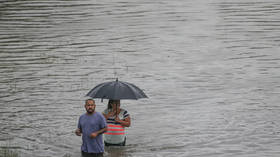'Catastrophic flooding' threatens heart of Texas oil industry

Flooding from a tropical storm hit the Houston area on Thursday, with some calling the situation worse than Hurricane Harvey.
Heavy rainfall inundated the Texas coast, flooding Houston and Beaumont, home to massive oil refining, petrochemical and export facilities. The storm was downgraded to just a tropical depression, but those classifications only measure wind speed. The real threat from Imelda was “major, catastrophic flooding,” according to the National Weather Service.
“Extremely persistent thunderstorms” created the potential for 6 to 12 inches of rain, with higher levels in certain areas. “Storm total rainfall could be in excess of two feet for some areas before the weather finally begins to improve!” the NWS said in a notice. The forecast predicted that through Friday, some parts could see rain reach as high as 25 to 35 inches.
Also on rt.com Giant tornado spotted in Texas as multiple states face onslaught of extreme weather (VIDEO)But the Texas Department of Transportation said on Thursday that 41 inches of rain had already hit the area between Beaumont and the town of Winnie (between Beaumont and Houston).
The sudden and rapid flooding of the area caught many by surprise, with thousands of people trapped in their homes and cars. Texas Gov. Greg Abbott said that the floods have “caused widespread and severe property damage and threatens loss of life.” He declared a state of disaster across 13 counties. The slow-moving nature of the storm meant that intense rain continued to pummel the region.
The intense flooding echoes the 2017 catastrophe from Hurricane Harvey, which submerged Houston with 50 inches of rain. In fact, some people said current flooding conditions are even worse. “What I'm sitting in right now makes Harvey look like a little thunderstorm,” Chambers County Sheriff Brian Hawthorne told ABC13, a local ABC affiliate. “It's dire out here. I'm fearful for this community right now.”
Also on rt.com Oil at $100 per barrel? Attack on Saudi refineries could shake oil market furtherHurricane Harvey left widespread destruction in its wake, including to a string of oil refineries and petrochemical complexes that dot the Texas and Louisiana Coast. It was the most powerful hurricane to hit Texas in decades and dumped a year’s worth of rain on the Houston area in just a few days. Nearly 4 million barrels per day of refining capacity was knocked offline, with several facilities taking weeks to recover. WTI prices plunged as crude oil became trapped, left unprocessed and with nowhere to go.
Disruptions from Tropical Depression Imelda won’t rival those of Hurricane Harvey, but heavy industry has indeed been affected.
ExxonMobil said on Thursday that it was shutting down its 370,000-bpd Beaumont, Texas refinery because of flooding. “Exxon Mobil's Beaumont refinery and chemical complex is conducting a preliminary assessment to determine the impact of the storm,” an Exxon spokesman said. “The Beaumont chemical plant has completed a safe and systematic shutdown of its units.”
Other refineries continued to operate normally. Valero said its Port Arthur refinery did not see disruptions.
The outage will likely be only temporary, and energy markets probably won’t skip a beat, with focus rightly concentrated on the Middle East. But the cleanup on the Texas coast for ordinary people will be more grueling, especially since some people only recently rebounded from the damage of Hurricane Harvey.
More importantly, it is a reminder of the vulnerability of the US energy complex, much of which is concentrated along the Texas and Louisiana coast. Climate change is bringing more intense storms to the region, putting more oil and refining assets at risk.
The industry is only doubling down on investments in the area. Billions of dollars are being funneled into refineries, ethane crackers and plastics manufacturing, storage tanks and export facilities. For instance, ExxonMobil has a 10-year, $20 billion “Growing the Gulf” campaign, which consists of 11 facilities. Earlier this year, Exxon and Qatar gave the greenlight for a $10 billion LNG export facility in Sabine Pass, Texas. Major crude oil export terminals are also in the works, seeking to double US oil export capacity in just a few years.
The odds are rising that in any given year, they will be threatened by severe weather. It’s rather striking that a run-of-the mill tropical depression led to catastrophic flooding in Houston this week, and forced the temporary shutdown of Exxon’s massive Beaumont refinery. It’s the kind of story that is increasingly moving from the “freak event” category and into the realm of an annual occurrence.
This article was originally published on Oilprice.com














